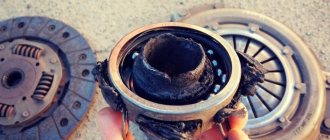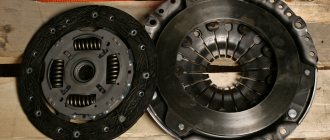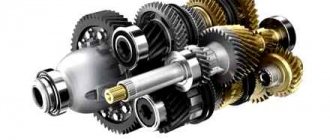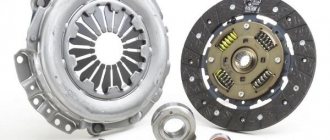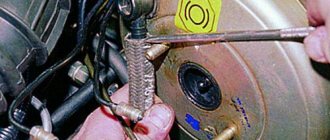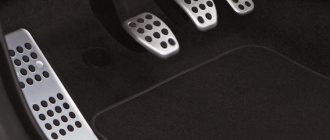Like any complex mechanism, the clutch fails from time to time. Listed below are the types of breakdowns, their symptoms, the reasons why this occurs, and tips for troubleshooting.
Experienced drivers are well aware of the design and principle of operation of the clutch. But among beginners, not everyone can boast of such knowledge. Therefore, before talking about malfunctions, it makes sense to understand what they are.
Model...
The physical principle on which the operation of the coupling is based is the presence of frictional force between the contacting surfaces. A simplified model of this device can be represented as two coaxial disks, a master and a slave. One of them can move under the action of a control lever. The first is connected to the drive. The second one is connected to the transmission.
When starting to move, the driver “squeezes the clutch” and the discs separate. The slave is motionless, i.e. the clutch is in the "disengaged" position. Then the driver engages first gear, adds gas and gradually releases the pedal. The disks are getting closer. At some point, their surfaces begin to contact each other, but still with slipping.
Therefore, the slave also begins to rotate, but its torque is less than that of the master. Next, the first disk is pressed more tightly against the second, slippage decreases, and the driven one rotates faster and faster. After the disks are completely pressed against each other, the slippage is zero and the angular velocities are the same. The clutch is engaged.
...And in reality
Compared to the physical model described above, the car clutch will be more complex. Although the principle of operation is the same. The main nodes are:
- Basket. Screwed to the flywheel. In its center there are pressing petals, and on the inside there is a movable pressure disk.
- Driven disk on the gearbox shaft. In its center there are damper springs in a circle. On one side there is a flywheel, on the other there is a basket.
- Movable release bearing. Makes the petals bend.
For better contact, both discs have wide annular surfaces with increased roughness. The same goes for the flywheel.
If the clutch is engaged and the motor is connected to the transmission, the pressure plate presses the driven one against the flywheel. When the driver presses the clutch pedal to turn it off, the bearing bends the petals. The discs move apart. The connection between the motor and the transmission is interrupted.
When the pedal is completely released, the pedal returns to its original position. The friction planes again touch one another and remain in this state, imparting torque from the engine to the gearbox. That. The car's clutch is a normally engaged mechanism.
Clutch operating principle
The clutch is responsible for transmitting torque from the engine to the gearbox. Its main task is to disconnect the units at the moment of switching speed. It is worth noting that this mechanism is different on cars with automatic and manual transmissions. On engines with a robotic transmission, the interaction with the engine is slightly different, and its functions are controlled electronically.
If we omit all the nuances, the clutch consists of the following components:
- The drive connects the pedal and the clutch itself (there are several options: mechanical, with a cable and hydraulic). On a robotic transmission, the drive is activated by an actuator, which receives commands from the ECU.
- Basket. Consists of a release bearing and a pressure plate.
- Driven disk.
- Fork.
- Damper springs.
- Control pedals.
When you press the pedal, force is transmitted to the clutch fork via a cable or hydraulic cylinder. The fork, through the release bearing, mechanically acts on the petals of the pressure plate, which, under the influence of this force, bends towards the flywheel. This causes the driven and driven discs to lose traction and the engine to idle without any load on the wheels.
Clutch functions on a car
The clutch serves to transmit torque from the engine to the gearbox, after which the torque is transmitted to the wheels. In simple terms, the clutch disc is pressed against the flywheel on the crankshaft.
It is possible to press and release the disk from the flywheel using the clutch pedal, with which the driver actually acts on the clutch drive. When the pedal is in the up position (the pedal is not pressed), the disc is pressed. If the pedal is depressed, the disc and flywheel are disconnected. It turns out that by pressing the pedal the driver disengages the clutch.
The clutch drive on modern cars is mechanical and hydraulic (or electro-hydraulic). The first option is relatively simple and cheap. Installed mainly on budget passenger cars. If we omit the technical details, the point is that the clutch pedal is connected to the drive via a sheathed steel cable. The mechanism for adjusting the free play of the pedal is located on the same cable.
In the hydraulic version, the cable is replaced by cylinders (as in a brake system) and the principle of incompressible fluid (in this case, brake fluid) is used. Most often, a hydraulic drive is installed in modern cars, since it is more advanced and reliable. In any case, when the car has a too soft clutch pedal, gears do not engage and other difficulties arise with shifting, normal operation without repair is simply impossible.
How the clutch works, what are its typical malfunctions, and how to avoid them
An important element of a manual transmission is the clutch, which serves to briefly disconnect the engine from the transmission. In addition, the clutch is a kind of damper that protects the engine from overloads. How does it work and how to extend its life?
How does the clutch work?
Most passenger cars with a manual transmission use a dry single-plate clutch. Its design is quite simple: it consists of two mutually adjacent disks - a drive (basket) and a driven one, a release bearing and a drive system. In the single-disc version, the transmission input shaft fits into a splined clutch in the center of the driven disk, and the surfaces of the engine flywheel, driven disk linings and basket pressure disk fit tightly together. Due to this, the transfer of power flow from the engine to the gearbox is ensured, and a working clutch calmly “digests” all the power developed by the engine.
In everyday life, the clutch drive disc, which includes a pressure plate (with a smooth shiny surface), a diaphragm spring (petals in the center) and a casing, is called a basket
When you press the clutch pedal, the release bearing acts on the plate springs of the basket, causing the surfaces of the driven and driving discs to separate. Accordingly, the input shaft is disconnected from the flywheel - that is, the engine and gearbox are physically disconnected, which allows you to change gear or engage neutral. When the clutch is engaged (the pedal is released), the release bearing stops pressing on the leaf springs, and the discs close again, and the damper springs in the central part of the driven disc dampen the torsional vibrations that occur during movement.
The four damper springs of the clutch driven disc are clearly visible, as well as the worn friction linings
When the clutch operates normally, it does not attract attention to itself. But if it malfunctions, the driver, for example, will not be able to shift gears or move away. What problems are possible?
Clutch mechanism of VAZ 2107
The VAZ 2107 clutch is a rather complex mechanism consisting of several dozen elements. The reasons for its malfunction can be very different. However, they can all be divided into two groups:
- Defects in the clutch mechanism itself. These include malfunctions of the driven part of the clutch, pressure device, basket, flywheel, and clutch fork.
- Defects in the hydraulic drive of the clutch mechanism. They can be caused by leakage of the working fluid, the formation of an air lock in it, as well as malfunctions of the main or working cylinders (MCC and RCC) and the pedal mechanism.
The clutch, like any other car part, has a limited service life. First of all, it depends on the skill of the driver, and therefore is not regulated by the manufacturer. To increase the service life of the clutch, it is necessary to adjust it in time, monitor the level of working fluid, avoid off-road driving, and learn the skills of using the clutch correctly.
It must be remembered that in addition, the clutch is a safety device that protects the transmission from serious damage when the rear wheels are blocked by various obstacles. The car is stuck in a quagmire, the drive wheels are stuck, the engine power is enough to turn the stuck tires. In this case, the clutch will begin to slip, protecting the gearbox, cardan and rear axle from damage. Yes, the driven disc linings will burn out. Yes, the clutch will overheat, which can cause the steel flats to warp or weaken the spring plates. But more expensive units will be protected from breakdowns.
Classic VAZ models have a dry, permanently closed single-plate clutch . It includes two main elements:
- Leading part. It consists of a driven disk, the splined part of which transmits rotation to the gearbox due to friction between the friction linings and the surfaces of the flywheel and pressure plate.
- Non-removable drive unit (basket). The basket is attached to the flywheel and consists of a pressure plate and a diaphragm pressure spring.
Classic VAZ models use a single-disc dry, permanently closed clutch: 1 - flywheel; 2 — clutch driven disc; 3 — clutch basket; 4 — release bearing with clutch; 5 — hydraulic clutch reservoir; 6 - hose; 7 — master cylinder of the hydraulic clutch release; 8 — servo spring of the clutch pedal; 9 — clutch pedal return spring; 10 — clutch pedal travel limit screw; 11 — clutch pedal; 12 — hydraulic clutch release pipeline; 13 — ball joint fork; 14 — clutch release fork; 15 — release spring for clutch release fork; 16 - hose; 17 — working cylinder of the hydraulic clutch release; 18 — clutch bleeder fitting
The clutch mechanism must be reliable, durable, and capable of dampening fluctuations in engine torque. The clutch has a hydraulic drive consisting of:
- clutch master cylinder;
- clutch slave cylinder;
- clutch on/off forks;
- release bearing;
- foot pedal.
The main reasons for a soft clutch pedal
To depress the clutch pedal when the drive is fully operational, you need to apply a certain force. This setting can be adjusted. Some drivers deliberately use a soft clutch. However, most often this is a sign of breakdowns and malfunctions, especially if the driver notices a difference compared to the norm. For mechanical and hydraulic drives, the problems will be different, not counting cases of mechanical failure of some parts.
- Let's start with the hydraulic clutch drive. First of all, air in the system is a common problem. During any repair of the hydraulic drive, air enters the tubes. This makes the pedal stroke soft. In this case, you should check the quality of tightening of the pipeline fittings, and also bleed the entire system (bleed the hydraulic drive).
You can also highlight a malfunction of the clutch slave and master cylinders. The working cylinder most often jams, and when the main cylinder fails, it loses its tightness and, as a result, its pumping capacity.
If the clutch pedal becomes soft in the cold season after the car has been idle, and during warming up everything returns to normal, then you need to check the master cylinder. Most likely his cuff will have to be replaced.
- The mechanical clutch drive is also characterized by a number of breakdowns. It is more difficult to identify a problem in a mechanical clutch drive, since you will often have to disassemble the crankcase and get to the release bearing.
Its deformation, as well as the breakage of the drive foot, are most often the cause of a soft clutch. The problem may also be associated with the destruction of one or more damper springs of the driven disk. Often this can also be found out only after disassembly.
